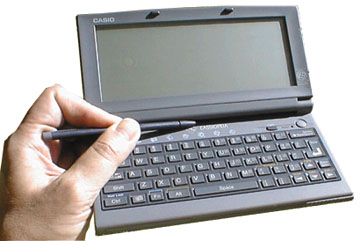Casio Cassiopeia A-20A sleeker, faster, more grown-up handheld PC As one of the first companies to ship a Windows CE-based handheld PC last Fall, Casio was able to gather a lot of experience and user feedback. This is evident in the new Cassiopeia A-20, one of the emerging class of second generation handheld PCs, and a device much improved compared to its predecessor, the Cassiopeia A-10. The first thing we noticed is that the 480x240 screen--standard to all first generation CE devices except those from HP--is gone. Instead, the A-20 has a wider 640x240 LCD. We much prefer this configuration and are glad to see that it appears to have become the new standard for HPCs. The second impression is that the A-20 has a sleeker, more elegant appearance than any of the first generation devices, and that it somehow looks more grown up. However, in terms of size, the new unit is just as small and handy. The larger screen makes it a bit wider, but the A-20 is actually thinner than the A-10/11. The A-20's keyboard is noticeably improved. Its QWERTY layout now measures 65% of a standard keyboard instead of the A-10's 59%. Individual keys are a bit wider than before and they feel much better to the touch. The looseness of the A-10 keys is gone, and the keys now offer precise tactile feedback. Casio also added a special function key, labeled Fn, that is used to provide direct access to the units built-in applications. Impressive performance Things have changed under the hood as well. Whereas the A-10 series used a 40Mhz version of Hitachis SH-3 32-bit RISC processor, the A-20's is running at 80MHz. The new chip, in conjunction with Windows CE 2.0 improvements, provides a much appreciated performance boost. The A-10's performance was unimpressive even compared to its first generation competitors, but the A-20 feels nimble and responsive. It raced through the PCM scroll test in just 18 seconds, almost three times faster than the A-10, and also two seconds faster than the first generation champ, the Velo-1. As of this writing, the Cassiopeia A-20 is the fastest HPC device we've tested.
What else is new and improved? For starters, the A-20 has a built-in microphone to go with the bundled Voice Notes application from ART. Of the first generation devices, only the Velo-1 had an internal microphone, and the Hitachi/LG twins offered an optional headset. Following HP's example, Casio has also added a Compact Flash memory slot, leaving the PC Card slot available for other applications. Memory has been expanded as well. Both RAM and ROM doubled from 4 to 8MB. Contrast control is now via keyboard, and the backlight is much brighter than before. The latter change is especially welcome as the A-10s backlighting was barely adequate. Casio also claims that the Cassiopeia A-20s battery life is twice that of the A-10, due to higher processor efficiency and new energy management. As of the writing of this review, Casio planned on bundling an impressive array of software with each A-20. Expect to see bSquare bFAX enhanced, CIC QuickNotes, the Landware Financial Calculator, Puma IntelliMigrate and a trial version of IntelliSynch, SkyTel 2-way messaging, Socket 1-way paging, Microburst Virtual Courier for ccMail and MS Mail.Exchange, ART Voice Notes, Command & Contacts, and a trial version of Symantec pcAnywhere CE. The A-20 also comes with Casio's own QV-LINK, Communications Center, Project Scheduler, Find File, Paint-Atlas, Argo Builder, and Sound Vega. Where does that leave those faithful early adopters who bought an A-10 or A-11? If you must have the great new screen, you'll just have to part with $599.95 to get a new A-20. If, however, you can live with the narrower screen of your old A10 or A11, Casio offers a $99.95 CE 2.0 upgrade for any of its first generation models purchased before September 8th, 1997. Those who bought an A-11 or A-11+ from September 8th through the end of 1997 receive a free upgrade kit that includes Windows CE 2.0, 2MB of RAM, and a manual. Overall, the Cassiopeia A-20 is a much improved HPC. It is much
faster, has better backlighting, a better keyboard, offers better battery life, lets you
take full advantage of all those great new CE 2.0 features, and it's made by a company
that is obviously very serious about the Windows CE platform. |
||
[Features] [Showcase] [Developer] [Members] [Subscribe] [Resources] [Contacts] [Guidelines] All contents ©1995-1998 Pen
Computing Magazine, Inc. All rights reserved. |




